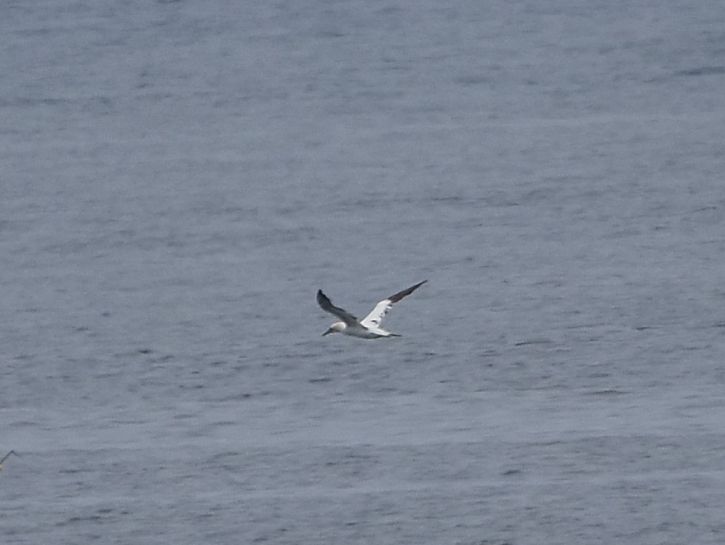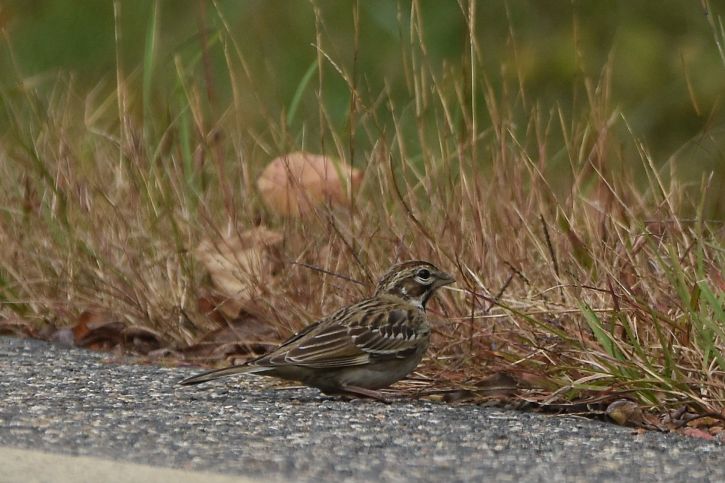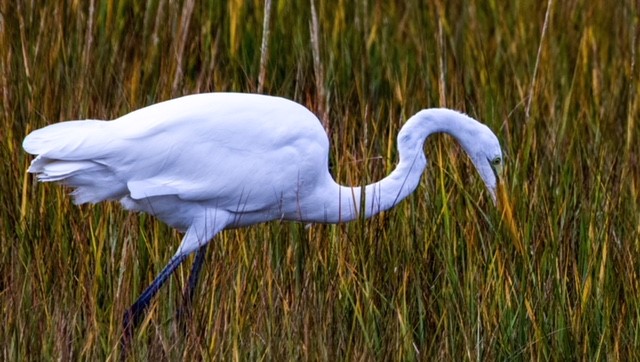Wednesday Morning Birding is one of Joppa Flats’ weekly outings to find birds at hotspots on Plum Island and in the Newburyport area. These reports highlight what we find.
Bird populations here on the coast have been in great flux over the past few weeks, and our outing this Wednesday was in great contrast to last week’s. We began at the Joppa Park boat ramp, where the tide was quite low. The flats and shallows were full of birds, some of which we had to work on from over a mile away.
When we arrived, something had put up many of the shorebirds, and we could see a flock of over 200 Dunlin, along with many Black-bellied Plovers. While it had seemed that the shorebird migration was waning, this week there was a strong pulse. There were some Semipalmated Sandpipers in the mix out there, and we saw as many as four or five Short-billed Dowitchers nearby.

Dowitchers in flight over Joppa Flats © Mike Densmore
Many small flocks of yellowlegs foraged and flew back and forth, with Lessers seeming to outnumber Greaters this week. Double-crested Cormorants were everywhere in great numbers, especially perched on rocks in the estuary, as well as flying south over the ocean in big, ragged flocks. A squadron of cormorants began feeding cooperatively in shallows far off toward Plum Island.
Joining them were close to 200 Bonaparte’s Gulls, terns we could not identify but feel may well have been Forster’s, and even some Great Egrets. Three Mute Swans preened on the mud, as did one tern that looked like it had enough black at the back of the head and brown in the body to be a juvenile Common Tern, which would be quite late.

Yellowlegs over Joppa Flats © Susan Balser
After a good long time of staring at all that bird bounty, we headed for the island. Hearing that Tom Wetmore had sighted Forster’s Terns, we went to the platform at parking lot #1 to find a real show going on with Northern Gannets, which flew about all over the ocean. Many of them were more than a half mile out, but a few occasionally came in for closer looks.
Although the gannets were not doing much diving, there were clearly some food fish near the surface, as we saw more than one fish jump out there, including one huge tuna that breached completely out of the water. Several Common Loons had taken up winter residency off the beach, and a couple of skeins of Black Scoters and a few White-winged Scoters flew south well out to sea.

Northern Gannet off Plum Island © Susan Balser
Arriving at the Main Salt Panne, we could see that the wintering population of American Black Ducks has arrived. They were scattered all over the pannes and any other water or even mud flats that we checked. I had seen many Northern Pintails earlier in the week, and thought we might have a good time with them at Bill Forward Pool, but we never made it that far.
As we came into the S-curves, a car was stopped and the birders in it were looking at a flock of sparrows ahead. After pausing a moment, we slowly caravanned through, and leapt out to enjoy a flock of Chipping Sparrows, a Lark Sparrow, and a female or juvenile Indigo Bunting. Other passerines were calling from the low forest, and a very confusing fall warbler showed for a few people who remained confused.
We heard that our banding station was beset by Yellow-rumped Warblers while we were out there, but we only found one by the road. This fall we have had very few warblers migrating through on our Wednesday outings.

Lark Sparrow on refuge road © Susan Balser
Since it is National Wildlife Refuge week, our friends at Parker River National Wildlife Refuge have opened the dike from Hellcat to The Warden’s, or Sub-headquarters. Having had so much excitement with passerines on the road, we thought it would be worth a stroll from North Pool Overlook to The Warden’s and back via the refuge road.
It was supremely lovely and fresh walking out there, and we enjoyed taking in the subtle beauty of the senescing marsh. But birdy it was not, so we will think of this annual tradition as a good moment of reflection on how fortunate we are to be spared fires, floods, and terrible winds here on the north shore.

Great Egret in The Great Marsh © Patti Wood
On the other hand, the current administration in Washington has taken the approach of death by a thousand cuts to progress once made toward a national, carbon-free energy system. Please write to your elected officials to encourage them to push back on this catastrophic reversal of our national agenda. Fortunately, we still march forward in states and municipalities, but we need to be unified. That is now a distant goal we can’t relinquish.
Our list for this week:
From Joppa Park boat ramp
- Mute Swan (3) – 1 ad, 2 juvs.
- American Black Duck (~ 30)
- Mallard – a few.
- Double-crested Cormorant – common.
- Great Blue Heron (1)
- Black-bellied Plover – common.
- Greater Yellowlegs – common.
- Lesser Yellowlegs – common .
- Semipalmated Sandpiper – common.
- Dunlin (200+)
- Short-billed Dowitcher (~ 12)
- Bonaparte’s Gull (~ 200)
- Ring-billed Gull – common.
- Herring Gull – common.
- Great Black-backed Gull (~ 6)
- tern sp. (1) – at a distance, appeared to be juv. Common Tern — quite late, though.
Plum Island
- Canada Goose (6) – pannes.
- American Wigeon (3) – pannes.
- American Black Duck – common.
- Mallard – a few.
- White-winged Scoter (7) – parking lot one ocean.
- Black Scoter (~ 28) – parking lot one ocean (2 flocks: 13 & ~15).
- Common Loon (5) – parking lot one ocean.
- Northern Gannet (~ 25) – parking lot one ocean.
- Double-crested Cormorant – 2 large flocks flying south.
- Great Egret (7) – marsh/various.
- Turkey Vulture (2)
- Northern Harrier (2)
- Red-tailed Hawk (1) – refuge entrance.
- Herring Gull
- Rock Pigeon – many, n. of refuge entrance.
- Eastern Phoebe (1) – S-curves.
- Blue Jay (~ 6) – S-curves.
- Northern Mockingbird (6) – 1, lot #1; 5, North Pool Overlook dike.
- European Starling – common.
- Yellow-rumped Warbler (1) – S-curves [Note: 41 Yellow-rumps banded at banding station].
- Eastern Towhee (2) – S-curves.
- Chipping Sparrow (~ 12) – flock of ~10 roadside; 2, S-curves.
- Lark Sparrow (1) – S-curves (feeding roadside w/ Chipping Sparrows & Indigo Bunting).
- Song Sparrow (~ 6)
- Dark-eyed Junco (1) – S-curves.
- Northern Cardinal (1) – S-curves.
- Indigo Bunting (1) – female, S-curves.
- House Sparrow



Nice Blog. Thank you. I go birding to enjoy the beauty of the bird and of the Islands and surrounds. Wisdom might suggest that we leave politics out of these reports. Far be it from me to know… Just a simple birder with marginal knowledge of things greater than this. Respectfully in Peace.